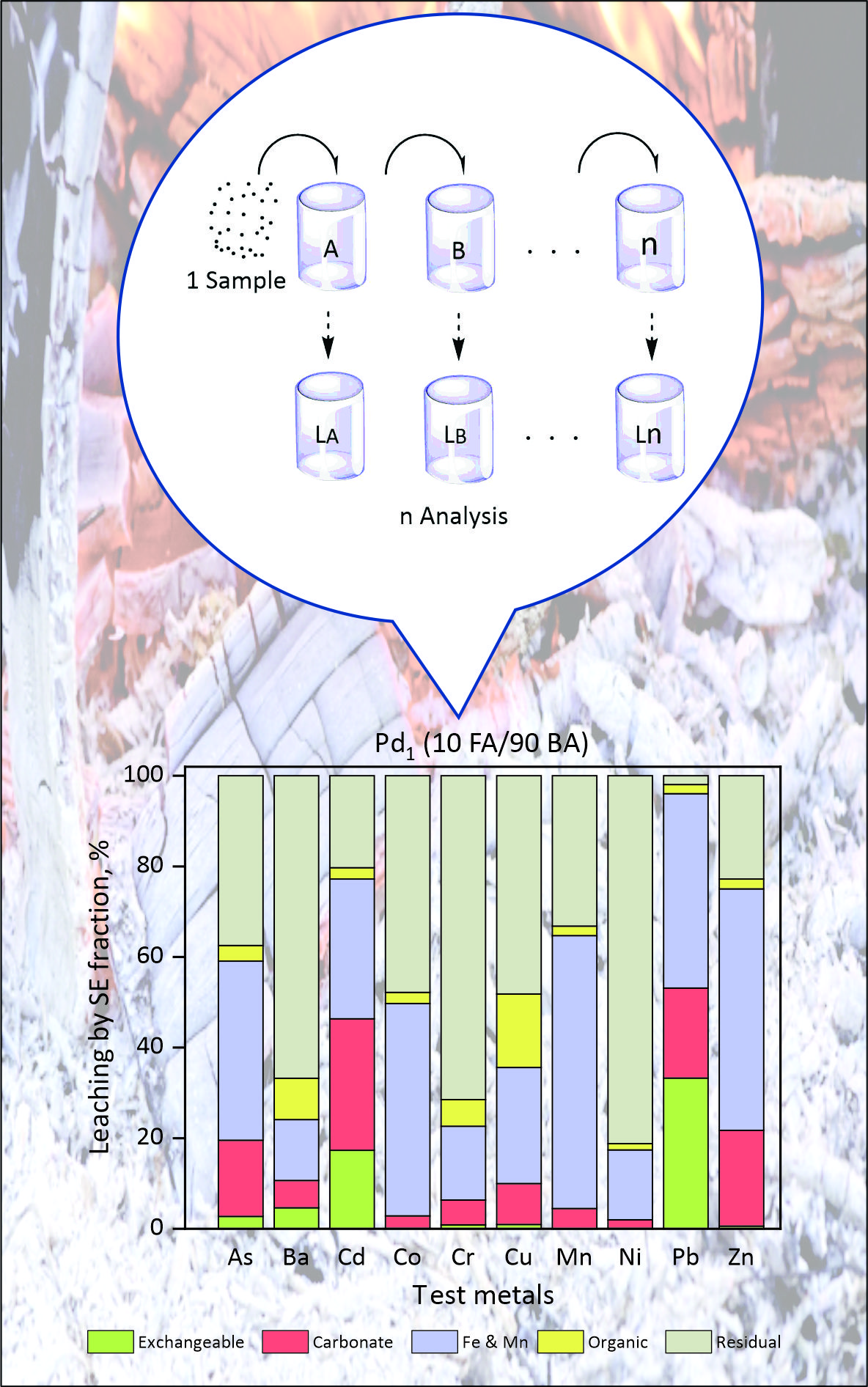Leaching of heavy metals from wood biomass ash, before and after binding in cement composite Scientific paper
Main Article Content
Abstract
Wood ash is a complex mixture of inorganic and organic compounds. It is heterogeneous in composition, which can vary considerably. Ash is mainly disposed of in landfills, which creates a risk for air, soil and groundwater contamination by trace elements. In order for wood biomass ash to be used as a secondary raw material, it is necessary to perform leaching tests, to determine which microelements it contains, and which of them could be released into the environment during the ash disposal. Sequential extraction (SE) showed that in the exchangeable and carbonate fraction, the most volatile metals As, Cd, Zn and Pb are released the most from the ash of deciduous trees, while the leaching of ash from coniferous trees is significantly lower. The evaluation of risk assessment code (RAC) for the tested biomass ash samples, indicates that Pb is a high-risk leaching element due to its condensation on the ash particles. By performing toxicity characteristic leaching procedure (TCLP) and synthetic precipitation leaching procedure (SPLP) tests, it was established that the released concentrations of tested metals are below the maximum allowable concentration, given by the regulation. The leaching tests of composites, prepared from wood ash in combination with cement, indicate that the leaching of ash is reduced to a minimum, and that all heavy metals are bound in a cement matrix, which indicates the possibility of using wood ash for construction purposes.
Downloads
Metrics
Article Details

This work is licensed under a Creative Commons Attribution-NonCommercial-NoDerivatives 4.0 International License.

Authors retain copyright and grant the journal right of first publication with the work simultaneously licensed under a Creative Commons Attribution license 4.0 that allows others to share the work with an acknowledgement of the work's authorship and initial publication in this journal.
Funding data
-
Ministry of Scientific and Technological Development, Higher Education and Information Society
Grant numbers 19032/961-116/19
References
M. Jakubus, N. Tatuśko, Pol. J. Soil Sci. 49 (2017) 195 (http://dx.doi.org/10.17951/pjss.2016.49.2.195)
B. Milovanović, N. Štirmer, I. Carević, A. Baričević, Građevinar 71 (2019) 505 (https://doi.org/10.14256/JCE.2546.2018) (in Croatian)
M. Jukić, L. Ćurković, J. Šabarić, M. Kerolli-Mustafa, Bull. Environ. Contam. Toxicol. 99 (2017) 524 (https://doi.org/10.1007/s00128-017-2160-0)
J. Kalembkiewicz, D. Galas, E. Sitar–Palczak, Pol. J. Environ. Stud. 27 (2018) 2593 (https://dx.doi.org/10.15244/pjoes/80870)
R. Pöykiö, M. Mäkelä, G. Watkins, H. Nurmesniemi, O. Dahl, Trans. Nonferrous Met. Soc. China 26 (2016) 256 (https://doi.org/10.1016/S1003-6326(16)64112-2)
S. Vassilev, D. Baxter, L. Andersen, Ch. Vassileva, Fuel 105 (2013) 40 (https://doi.org/10.1016/j.fuel.2012.09.041)
Y. Xiong, F. Zhу, L. Zhao, H. Jiang, Z. Zhang, J. Mater. Cycles Waste Manage. 16 (2014) 608 (https://doi.org/10.1007/s10163-014-0274-6)
C. Rodriguez-Navarro, E. Ruiz-Agudo, A. Luque, A. B. Rodriguez-Navarro, M. Ortega-Huertas Am. Mineral 94 (2009) 578 (https://doi.org/10.2138/am.2009.3021)
L. Radačovská, M. Holubčík, R. Nosek, J. Jandačka, Procedia Eng. 192 (2017) 759 (https://doi.org/10.1016/j.proeng.2017.06.131)
R. Nosek, M. Holubčík, J. Jandacka, Bioresources 11 (2016) 44 (https://bioresources.cnr.ncsu.edu/BioRes_11/BioRes_11_1_44_Nosek_HJ_Impact_Bark%20Content_Wood%20Biomass_Biofuel%20Properties_8076.pdf)
Pravilnik o dozvoljenim količinama opasnih i štetnih materija u poljoprivrednom zemljištu i vodi za navodnjavanje i metodama za njihovo ispitivanje, Službeni Glasnik Republike Srpske 56/16 (https://www.vladars.net/srSPCyrl/Vlada/Ministarstva/mps/Documents/Pravilnik%20o%20dozvoljenim%20kolicinama%20opasnih%20i%20stetnih%20materija_481764224.pdf) (in Serbian)
M. Dalmacija, PhD Thesis, University of Novi Sad, Novi Sad, 2010 (https://hdl.handle.net/21.15107/rcub_nardus_1755) (in Serbian)
S. A. Akinyemi, A. Akinlua, W. M. Gitari, S. M. Nyale, R. O. Akinyeye, L. F. Petrik, Energy Sci. Technol. 3 (2013) 28 (http://dx.doi.org/10.3968/j.est.1923847920120301.161)
T. Sano, S. Miura, H. Furusawa, Sh. Kaneko, T. Yoshida, T. Nomura, S. Ohara, J Wood Sci. 59 (2013) 307 (https://doi.org/10.1007/s10086-013-1337-3)
D. Smołka‑Danielowska, M. Jabłońska, Int. J. Environ. Sci. Technol. 19 (2022) 5359 (https://doi.org/10.1007/s13762-021-03506-9)
I. Carević, N. Štirmer, M. Trkmić, K. Kostanić Jurić, Appl. Sci. 10 (2020) 8704 (https://doi.org/10.3390/app10238704)
G. E. Schwartz, J. C. Hower, A. L. Phillips, N. Rivera, A. Vengosh, H. Hsu-Kim, Environ. Eng. Sci. 35 (2017) 728 (https://doi.org/10.1089/ees.2017.0347)
M. Šyc, M. Tošnarová, J. Hrma, M. Pohořelý, K. Svoboda, M. Punčochář, in Proceedings of E3S Web of Conferences Environment, Energy and Earth Sciences (2013) France, published by EDP Sciences, Article Number 20011 (https://doi.org/10.1051/e3sconf/20130120011)
D. Drljača, PhD Thesis, Faculty of Technology, University of Banja Luka, Banja Luka, 2020 (in Serbian) (https://fedora.unibl.org/fedora/get/o:1300/bdef:Content/get)
Y. Pan, Z. M. Wu, J. Z. Zhou, J. Zhao, X. X. Ruan, J. Y. Liu, G. R. Qian, J. Hazard. Mater. 261 (2013) 269 (https://doi.org/10.1016/j.jhazmat.2013.07.038)
R. Świetlik, M. Trojanowska, P. Rabek, Chem. Speciation Bioavailability. 25 (2012) 63 (https://doi.org/10.3184/095422912X13497968675047)
L. C. Mollon, G. J. Norton, L. Trakal, E. Moreno-Jimenez, F. Z. Elouali, R. L. Hough, L. Beesley, Environ. Pollut. 218 (2016) 419 (https://doi.org/10.1016/j.envpol.2016.07.021)
Pravilnik o kategorijama, ispitivanju i klasifikaciji otpada, Sl. Glasnik Republike Srbije, br. 56/2010 (in Serbian)
Pravilnik o uslovima ispuštanja otpadnih voda u površinske vode, Službeni Glasnik Republike Srpske 44/2001 (in Serbian)
M. K. Tiwari, S. Bajpai, U. K. Dewangen, R. K. Tamrakar, J. Radiat. Res. Appl. 8 (2015) 523 (https://doi.org/10.1016/j.jrras.2015.06.003)
W. R. Roy, P. M. Berger, CCGP Journal 3 (2011) 63 (https://www.researchgate.net/publication/276230163_Geochemical_Controls_of_Coal_Fly_Ash_Leachate_pH)
G. Fava, T.R. Naik, M. Pierpaoli, Recycling 3 (2018) 46 (https://doi.org/10.3390/recycling3030046)
E. Menéndez, A. M. Álvaro, M. T. Hernández, J. L. Parra, J. Environ. Manage. 133 (2014) 275 (https://doi.org/10.1016/j.jenvman.2013.12.009)
N. Ristić, Z. Grdić, G. Topličić-Ćurčić, D. Grdić, V. Dodevski, Tehnički vjesnik 28 (2021) 495 (https://doi.org/10.17559/TV-20200214103332) (in Croatian).





